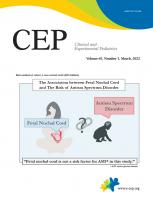Dyslipidemia in children and adolescents is a known major risk factor for cardiovascular disease in adulthood along with obesity [1]. In particular, since childhood lipid concentrations continue into adulthood, the early evaluation and treatment of dyslipidemia are required during childhood and adolescence [2]. Therefore, it is necessary to detect children and adolescents at risk of cardiovascular disease in adulthood by screening for dyslipidemia.
The Korean Society of Pediatric Endocrinology guidelines, based on National Heart, Lung, and Blood Institute recommendations, state that all children and adolescents aged 9–11 and 17–21 years of age require dyslipidemia screening, even if asymptomatic or lacking a family history. Testing for dyslipidemia is not recommended for children under 2 years of age. Routine screening tests are not performed for children aged 2–8 years and those 12–16 years of age. However, in this age group, if there is a family history of high-risk cardiovascular disease and dyslipidemia or risk factors such as hypertension, diabetes, and chronic kidney disease, targeted screening can be performed [3,4]. In addition, non-high-density lipoprotein cholesterol, which does not require fasting as a screening test and can predict cardiovascular disease in adulthood, is recommended [5].
Although the prevalence of dyslipidemia and obesity are increasing in children and adolescents in Korea [6], awareness of dyslipidemia as well as education about its prevention and treatment are insufficient.
This article reviews studies showing that dyslipidemia in children and adolescents is associated with the cardiovascular system as well as vitamin D levels, respiratory disease, and mental health [7]. Although the results of published studies are inconsistent, they are expected to be helpful in the recognition of serious health problems caused by dyslipidemia in children and adolescents.
Studies have reported that social distancing and activity restrictions implemented during the coronavirus disease 2019 (COVID-19) pandemic have exacerbated metabolic syndrome, including obesity and dyslipidemia, as a result of decreased physical activity and increased unhealthy food intake in adults [8]. Similarly, a recently published study in Korea reported that the prevalence of obesity, dyslipidemia, and vitamin D deficiency among children and adolescents are increasing due to school closures and physical activity restrictions during the COVID-19 pandemic [9], increasing awareness of the importance of health care for children and adolescents.
The increased prevalence of dyslipidemia is considered due to a westernized diet and reduced physical activity levels. Therefore, it is essential to change lifestyles by increasing the consumption of healthy foods, promoting breakfast, and decreasing screen time and regular activities for the treatment of dyslipidemia [10]. Although studies have examined the relationship between dyslipidemia and vitamin D, it is unclear whether vitamin D administration helps improve dyslipidemia. The primary treatment for obesity or dyslipidemia is lifestyle modification; however, it may be necessary to exercise indoors and take supplemental vitamin D to prevent cardiovascular disease and support bone health due to social distancing and the restriction of outdoor activities during the COVID-19 pandemic [9]. Drug treatment for dyslipidemia can be performed in children aged 10 years or older whose conditions do not improve despite lifestyle modifications and diet control for 6–12 months. Statins have been approved by the U.S. Food and Drug Administration for the first-line treatment of dyslipidemia in children aged 10 years and older. In Korea, almost 0.41% of children and adolescents with dyslipidemia require drug treatment [11].
To enable more effective evaluations or treatments of dyslipidemia in children and adolescents, it is necessary to select risk groups through a life-cycle health checkup program and utilize a system that can continuously provide individual preventive education and customized treatment in connection with medical institutions. There is also a need to develop better guidelines for the management of dyslipidemia through management system feedback. A large-scale integrated study is also needed because of the rarity of epidemiological statistics or drug treatment studies of dyslipidemia in children and adolescents in Korea.





 PDF Links
PDF Links PubReader
PubReader ePub Link
ePub Link PubMed
PubMed Download Citation
Download Citation


